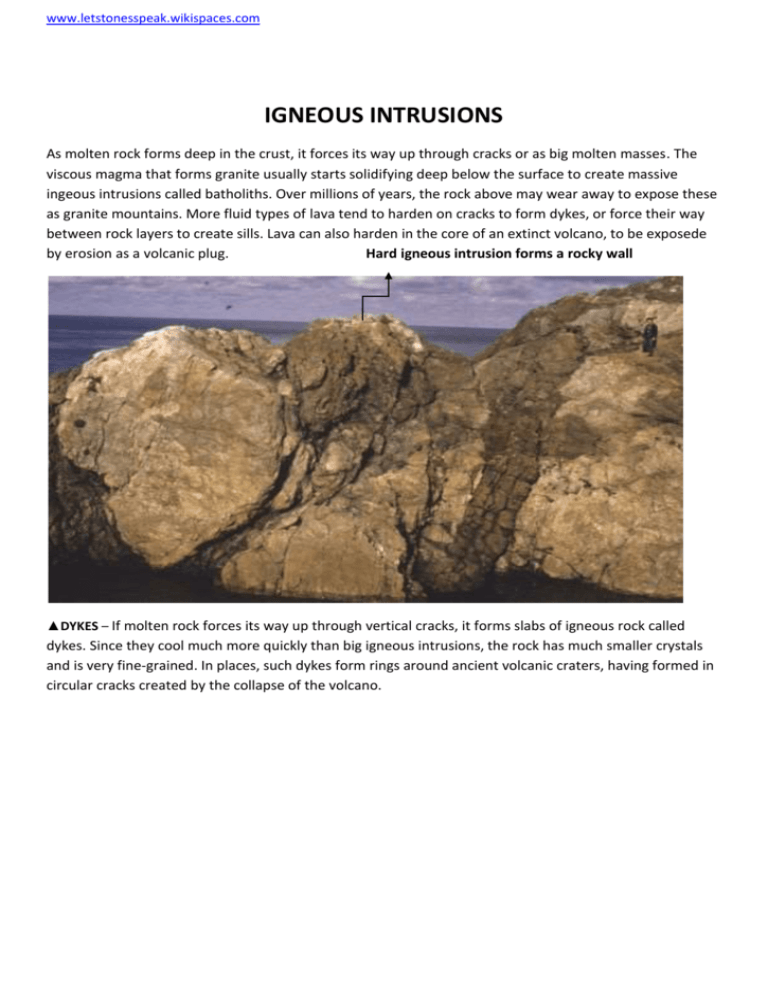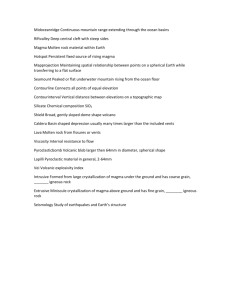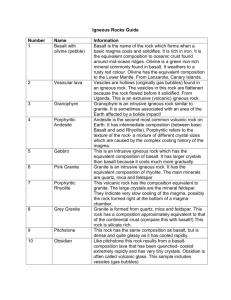IGNEOUS INTRUSIONS - Letstonesspeak
advertisement

www.letstonesspeak.wikispaces.com IGNEOUS INTRUSIONS As molten rock forms deep in the crust, it forces its way up through cracks or as big molten masses. The viscous magma that forms granite usually starts solidifying deep below the surface to create massive ingeous intrusions called batholiths. Over millions of years, the rock above may wear away to expose these as granite mountains. More fluid types of lava tend to harden on cracks to form dykes, or force their way between rock layers to create sills. Lava can also harden in the core of an extinct volcano, to be exposede by erosion as a volcanic plug. Hard igneous intrusion forms a rocky wall ▲DYKES – If molten rock forces its way up through vertical cracks, it forms slabs of igneous rock called dykes. Since they cool much more quickly than big igneous intrusions, the rock has much smaller crystals and is very fine-grained. In places, such dykes form rings around ancient volcanic craters, having formed in circular cracks created by the collapse of the volcano. www.letstonesspeak.wikispaces.com ▼GRANITE BATHOLITHS- The rounded mass of Sugar Loaf Mountain in Rio de Janeiro, Brazil, is just part of huge granite batholith that lies beneath the city. Originally formed deep in the crust, the granite is much harder than the surrounding rocks, which is why it has survived the erosion that has worn rhose other rocks away. A similar batholith forms the mountains of the Sierra Nevada in California, US. Granite of Sugar Loaf Mountain is 800 million years old ▼ FLOOD BASALTS- The Deccan Traps are sheets of basalt more than 2 km (1,2 miles) thick that cover 500,000 sq km (190,000 sq miles) of central India. They are igneous extrusions rather than intrusions, because they were formed by enormous outpourings og molten basalt that solidief in the layers visible in the cliffs. They erupted some 65 milion years ago, at exactly the same time as the dinosaurs became extinct, and the two events may be connected. www.letstonesspeak.wikispaces.com ▼VOLCANIC PLUGS- The magma chambers that lie nebeath volcoanoes can hardenin the same way as granite batholiths when the volcanoes are extinct. If the softer rock above then wears away, the hardened magma is revealed as a volcanic plug. The Devil´s Tower in Wyoming, US, formed like this. Asi t cooled, the rock shrank and fractured into the vertical columns that give it such a dramatic appearance. ▼SILLS- If molten rock intrudes between two layers od sedimentary rock, the result is a sill. It may forma t any angle, depending on the slope of the rock layers. The Whin Sill in Britain is a sheet of coarse basalt some 30m (100 ft) thick that lies at a slight angle. This exposes its edge, which has vertical joins like those of the Devil´s Tower. The Romans used i tas the basis for Hadrian´s Wall, marking the northern frontier of their empire.








